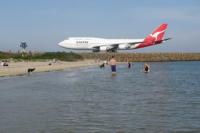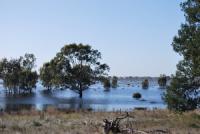-
U.S. moves to lessen dependence on foreign-sourced rare earth materials
Critical minerals are needed for many products used by Americans in everyday life. These minerals are also used to make many other products important to the American economy and defense. The assured supply of these critical minerals is thus essential to the U.S. economic security and national defense. Currently, the United States is heavily dependent on foreign sources of critical minerals – importing more than 50 percent of the U.S. annual consumption of 31 of the 35 minerals. The U.S. relies completely on imports to supply its demand for 14 critical minerals.
-
-
WhatsApp's loophole reveals role of private companies in cyber-surveillance
Last month, WhatsApp’s latest security flaw was discovered, a flaw which allow governments to spy on dissidents, activists, and journalists. An Israeli cyber company is reportedly behind the loophole — and not for the first time.
-
-
Climate change already affecting global food production—unequally
The world’s top 10 crops — barley, cassava, maize, oil palm, rapeseed, rice, sorghum, soybean, sugarcane, and wheat — supply a combined 83 percent of all calories produced on cropland. Yields have long been projected to decrease in future climate conditions. Now, new research shows climate change has already affected production of these key energy sources — and some regions and countries are faring far worse than others.
-
-
ARCHANGEL: Securing national archives with AI and blockchain
Researchers are using its state-of-the-art blockchain and artificial intelligence technologies to secure the digital government records of national archives across the globe – including the U.K., Australia, and the United States of America.
-
-
The economic cost of devastating hurricanes and other extreme weather events is even worse than we thought
June marks the official start of hurricane season. If recent history is any guide, it will prove to be another destructive year thanks to the worsening impact of climate change. If this is not bad enough, there is this: a meaningful assessment of the costs of climate change – using basic economic principles I teach to undergrads – paints a scary picture indeed.
-
-
Silicon Valley’s scramble for China
In August 2012, China launched one of its first major “smart city” projects for the remote oil town of Karamay in the autonomous province of Xinjiang. “Information technology is not just about technology. It should be integrated with all aspects of life in our city and make people’s lives more convenient,” said then Karamay Mayor Chen Xinfa. Nafeez Ahmed writes in Coda Story that A report released last year by subsidiary Deloitte China, titled “Super Smart City: Happier Society with Higher Quality,” celebrates China’s drive to build “super smart cities” which integrate data across services like health care, transport, education and public safety. Billed by Deloitte as a virtual utopia, China’s smart cities represent the biggest and most intrusive surveillance architecture ever built by any single nation, according to experts and analysts.
-
-
Huawei and the U.S.-China supply chain wars: The contradictions of a decoupling strategy
In two dramatic policy announcements last month, the Trump administration effectively barred U.S. companies and government agencies from buying telecommunications equipment or services from – or selling any components to – Chinese technology champion Huawei. President Donald Trump signed a broadly phrased executive order restricting any transaction of information communication technology (products or services linked to a “foreign adversary” deemed to pose an “unacceptable risk to the national security of the United States”), while the Commerce Department placed Huawei the company and its affiliates on its Entity List – a designation that requires U.S. firms and foreign companies selling products that contain American components to acquire a license from the U.S. government before trading with a blacklisted company. Darren Lim and Victor Ferguson write in War on the Rocks that these moves represent the latest steps towards “decoupling,” the unwinding of the interlocking supply chains and trading relationships that have made the U.S. and Chinese economies so deeply interdependent over the past two decades. Whether deliberate or not, the restrictions on Huawei have prompted some to argue that we are witnessing the collapse of an open, global market for information communication technology goods and services. Others cite the new policies as the latest confirmation of an emerging “economic” or “technology” Cold War between China and the United States.
-
-
A study exposes the health risks of gene-editing human embryos
A missing chunk of DNA – called Δ32 mutation —is 32 base pairs long and smack in the middle of the CCR5 gene, might be the most studied mutation in human history. The spontaneous deletion, which arose thousands of years ago, has a striking relationship with one of the worst human diseases: HIV/AIDS. People who inherit this mutation from both of their parents are naturally immune. last year, a Chinese scientist named He Jiankui used Crispr to try to endow two human embryos with the Δ32 mutation and immunity to HIV. Megan Molteni writes in Wired that last week, it emerged that fertility clinics around the world have been seeking He’s advice on offering a CCR5 Crispr edit as a service to prospective parents. Now, new research is suggesting that such a procedure might actually be an early death sentence.
-
-
Agile scouting robots

Researchers have developed an agile robot, called Salto, that looks like a Star Wars Imperial walker in miniature and may be able to aid in scouting and search-and-rescue operations. Robots like this may one day be used to save lives of both warfighters and civilians, researchers said.
-
-
More intense wildfires are here to stay, and we need to adapt

Update on state of Canada’s mountain regions looks at human scale of ecological disaster wrought by changing climate. “Events that a decade ago we would call ‘100-year events’ are quickly becoming the norm,” said one researcher. We need to talk “about ways we can coexist with fire because it is our new reality.”
-
-
Rising seas threaten Australia’s major airports – and it may be happening faster than we think

Most major airports in Australia are located on reclaimed swamps, sitting only a few meters above the present-day sea level. And the risk of sea level rise from climate change poses a greater threat to our airports than we’re prepared for. Given the significant disruption cost and deep uncertainty associated with the timing of sea level rise, we must adopt a risk-based approach which considers extreme sea level rise scenarios as part of coastal infrastructure planning.
-
-
Rural areas more vulnerable to sea-level rise

Type “sea-level rise” in an internet search engine and almost all the resulting images will show flooded cities. But there is a growing recognition that sea-level rise will mostly impact rural land–much of it privately owned—where existing knowledge is insufficient o best inform private and public decisions on how to cope with the threat.
-
-
Scent-based strategy blocks mosquito transmission of disease
Could it be that your scent is just a bit too attractive? It is known that mosquitoes are drawn to certain human chemical odors that lead the insects to sources of food. New technology would temporarily modify skin microbiome to reduce attraction of disease-causing mosquitos by altering human scents.
-
-
Can we prepare for climate impacts without creating financial chaos?
Likely sooner than we think, the destruction that warmer global temperatures are inflicting — through record floods, wildfires, droughts, and hurricanes — could physically overwhelm our ability to maintain many communities in their existing form. Communities face a tricky dilemma as climate changes: How to prepare for impacts without scaring away homeowners and investors and setting off a damaging economic spiral.
-
-
Small device alerts responders to changes to thermal conditions
When firefighters rush into burning buildings, they know the thermal environment may change in a matter of seconds, exposing them to potentially lethal temperatures. Burn Saver is a body-worn technology that continuously monitors thermal conditions and warns firefighters when those conditions become threatening.
-
More headlines
The long view
The Future of Open Data in the Age of AI: Safeguarding Public Assets Amid Growing Private Sector Demands
AI offers immense potential, but that potential must be realized within a framework that protects the public’s right to its own information. The open data movement must evolve to meet this new challenge—not retreat from it.
Horses for Courses: Where Quantum Computing Is, and Isn’t, the Answer
Despite the impressive and undeniable strides quantum computing has made in recent years, it’s important to remain cautious about sweeping claims regarding its transformative potential.
Federal R&D Funding Boosts Productivity for the Whole Economy − Making Big Cuts to Such Government Spending Unwise
Large cuts to government-funded research and development can endanger American innovation – and the vital productivity gains it supports. If the government were to abandon its long-standing practice of investing in R&D, it would significantly slow the pace of U.S. innovation and economic growth.
Why Ukraine’s AI Drones Aren’t a Breakthrough Yet
Machine vision, a form of AI, allows drones to identify and strike targets autonomously. The drones can’t be jammed, and they don’t need continuous monitoring by operators. Despite early hopes, the technology has not yet become a game-changing feature of Ukraine’s battlefield drones. But its time will come.
New Tech Will Make Our Airplanes Safer
Odysight.ai’s technology allows for constant monitoring of aircraft, sending alerts in case of malfunctions that could lead to accidents.
New Technology is Keeping the Skies Safe
DHS S&T Baggage, Cargo, and People Screening (BCP) Program develops state-of-the-art screening solutions to help secure airspace, communities, and borders
